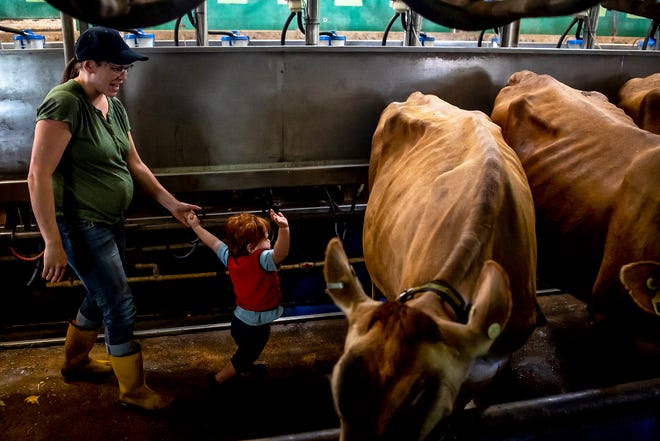
The newest hires are getting up to speed — a process that could be more time consuming than usual this year, said Carissa Itle Westrick, the farm’s director of business development. After weeks of struggling to fill positions for full-time work with benefits, the farm decided to rely more heavily on part-timers.
“Our sort of Plan B here is to hire a handful of high school kids looking for summer work,” said Ms. Westrick. “It’s not like the cows are going to cross their legs because we don’t have the right person here.”
Farming in Pennsylvania is an $81 billion-a-year industry, according to a 2021 report from the Pennsylvania Department of Agriculture, yet many farmers say local workers aren’t interested in taking the jobs available. And the struggles have become that much harder since labor shortages have hit other industries as pandemic shutdowns ease.
Those in the ag industry are competing with jobs in restaurants and warehouses that offer things that farmers can’t afford — like a bump in starting salary, a bonus just for applying, less labor intensive responsibilities and air conditioning.
“It’s even more challenging now to find people who want to work on farms than it was before,” said Jayne Sebright, executive director of the Center for Dairy Excellence, an advocacy organization based in Harrisburg.
‘We’re perennially short-handed’
Michael Kovach, owner of Walnut Hill Farm in Mercer County and vice president of the Pennsylvania Farmers Union, usually needs to hire only two workers to help out.
Even that hasn’t been easy this year.
His last employee was hired on the spot after the man showed up for an interview and, without being asked, took it upon himself to remove a piece of plastic that had become stuck in a tractor, Mr. Kovach said. The summer help he thought he had lined up for this year, however, showed up on day one, learned he was expected to come to work on the weekends and never returned.
“We’ve got this expectation that you can punch a clock and everything goes to sleep at a farm, but it doesn’t work that way,” Mr. Kovach said.
The last year “just amplifies all those same old things,” he said. “Basically if it was difficult to find good help before when there’s a dearth of labor, then it’s even more difficult (now.) It feels like we’re perennially short-handed.”
Employment of agricultural workers is expected to increase just 1% from 2019 to 2029, slower than the average for all occupations, according to the U.S. Bureau of Labor Statistics.
In 2020 — the most recent data available — there were about 7,050 workers in Pennsylvania in the farming, fishing and forestry sectors, according to the state’s Department of Labor and Industry.
For years, many Western Pennsylvania farmers have been worried about finding enough hands to help milk the cows, feed the livestock, and process and deliver orders. Some rely on local labor but say they have trouble finding people interested in farm jobs — and who will keep showing up for work. Others rely on foreign workers but have difficultly navigating federal guidelines to bring the employees to their farms.
Some blame the heat, long hours and labor intensive work for the struggles to bring in local employees. Others blame a lack of work ethic, and many point to generational shifts.
“Let’s be brutally honest, Americans don’t want to do manual labor,” said Marty Yahner, who runs a beef farm in Cambria County. “Not everybody can be a computer programmer. We still need the mechanics and the carpenters and the farmers and the truck drivers.
“Who the heck is going to run these farms and keep our world fed?”
Turning to foreign workers
For some of the larger local farms, the answer is foreign workers.
Some farmers rely on a federal program called H-2A that offers workers seasonal visas to labor in agriculture. Under the rules of the program, the farmers must provide things like housing and transportation and they must first look for U.S. workers to fill the roles.
One farmer in Butler County who has hired through the H-2A program but asked to remain anonymous to avoid scrutiny from the wage and hour division of the U.S. Department of Labor, which oversees the program, said those workers are “the best guys. No matter what I tell them to do, they do it with a smile.”
Yet the program comes with its drawbacks. He estimates he spends more than $5,500 before the workers even arrive on things such as transportation and lawyer fees. And he worries about following all the rules, which go into such detail as specifying that the housing for the workers must include a trash can with a lid.
The Trump administration moved to tighten restrictions on migrant workers and increase enforcement of some H-2A guidelines, which many farmers feared would leave them short-staffed. But most said their concerns never materialized.
“There was a squeeze, for sure, it just wasn’t as bad as it might have been,” said Dan Dalton, the Three Rivers hub manager with the Pennsylvania Association for Sustainable Agriculture, based in Harrisburg.
Still, farmers are pushing for more changes to the program to make it easier to find workers. The Butler County farmer wanted to get rid of the requirement that workers had to take a bus to the farm from their home country. He’d rather fly them in.
Dairy farmers and other sectors that need workers year-round instead of just seasonally say the program is off-limits to them because it doesn’t provide the option for a longer visa.
In March, the U.S. House of Representatives passed the Farm Workforce Modernization Act in part to address concerns with the H-2A program. The legislation would modify the minimum wage for H-2A workers, establish minimum work hours and make the program available for agricultural work that is not temporary or seasonal. It would also create a path to permanent resident status for eligible workers.
Keeping up with rising wages and AC
No matter where their workers are from, many farmers said the recent trend toward rising wages for entry-level jobs is making it even harder to drum up interest.
Those farmers looking to employ local workers find themselves competing against warehouse operators like Amazon that pledge a $15-an-hour starting wage or McDonald’s and other restaurants that are raising pay to attract more workers.
For H-2A workers, the federal government sets a required wage. This year that rate in Pennsylvania is $14.05 an hour, and farmers must match that salary for every worker hired for the same type of job, visa holder or not.
The Butler County farmer said that makes it impossible to hire high school kids because he can’t match that salary for people with little to no experience. The average wage on his farm before he started using the H-2A program was $10 an hour.
Across the state, entry-level workers in farming, fishing and forestry earn about $10.46 an hour, according to data from the Department of Labor and Industry.
Entry-level agricultural equipment operators make about $8.68 an hour. Farm workers and laborers who work with crops or in the nursery or greenhouse make about $9.69.
Farmers say they’re trying to keep up with the competition but don’t have the flexibility to make up for the extra expenses in other areas that some businesses do.
“It’s not like we’re going to sell milk for $20 a gallon,” said Ms. Westrick, from Vale Wood Farms. “Best Buy can charge whatever more for that TV … but when you’re selling a gallon of milk — particularly if you’re selling a gallon of milk for a pre-established price — you can’t build more into that price.”
Struggling to find workers and to pay them a competitive salary, some farmers are turning to automation, an investment that might have seemed too expensive before, said David Swartz, assistant director for animal systems programs at Penn State Extension, a program set up to offer training and resources to agricultural workers.
For example, he said, a computerized machine that can milk about 60 cows a day may cost $1,000 per cow, or about $60,000. It could replace one or two workers.
“It’s a significant investment for a small business owner,” Mr. Swartz said. “But now with labor shortages and the inflation in the hourly wages that have to be paid in order to be competitive, all of a sudden automation seems like a more reasonable decision.”
‘The ones that show up’
A lot of people don’t believe Steve Paxton when he says not much has changed on his dairy farm in Mercer County due to the COVID-19 pandemic.
The cows still need to be milked and he didn’t lose any workers. He actually saved some time looking for new employees when his seasonal workers switched to virtual learning instead of heading back to school.
When workers had to go into quarantine after a possible exposure to the virus — which happened two or three times last year — everyone else had to pick up the slack.
They were used to that, too.
About two years ago, the farm was so short-staffed that Mr. Paxton, his wife and his kids had to milk the cows themselves— a task that became too big for the family three decades ago as the farm grew.
He has raised wages to keep up with the local McDonald’s and he tries to employ only local workers — the other thing most people have trouble believing. He said he used to have at least a few high school kids every summer express interest in working on the farm but recently hasn’t seen that desire to work. He and his wife blame a lack of work ethic and responsibility.
Once he gets a worker, he said he tries to be lenient. He works around days off for prom and summer vacations, and he hires enough people to leave some wiggle room in the schedule. As long as workers communicate with him, he said he doesn’t pay much attention to how well they do their job.
“Dairy farming is not the most glamorous job in the world … people that do it do it because they love working with the animals,” Mr. Paxton said.
“Our best workers are the ones that show up.”























